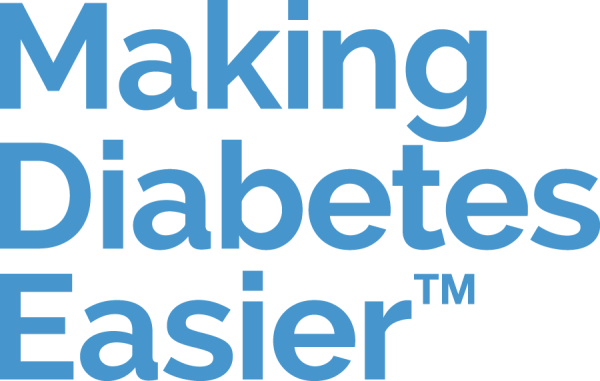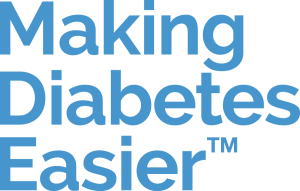What is type 2 diabetes?

Type 2 diabetes, previously known as non-insulin dependent or adult-onset diabetes, is the most common form of diabetes mellitus and accounts for 90% to 95% of people with diabetes [1,2,3,4].
This metabolic disorder is characterised by a decrease in the effects of insulin on body cells, called insulin resistance, and/or insufficient insulin production by the pancreas.
Since insulin regulates blood glucose levels, it leads to hyperglycaemia (high blood glucose). These abnormalities are most often triggered in people with a family history of type 2 diabetes and an unhealthy lifestyle (lack of exercise and poor eating habits), often resulting in weight gain or central obesity (fat around the stomach area) [1,3,5,6,7,8].
Symptoms
Before its onset, type 2 diabetes can develop silently for many years without noticeable symptoms [4]. For this reason, it is not uncommon for patients to discover that they have diabetes during a medical consultation initially made for other health concerns [3,4,6].
Therefore, even a person who does not experience any symptoms of type 2 diabetes may be affected by this condition.
Diabetes can also manifest itself through typical symptoms of hyperglycaemia, such as:
- fatigue;
- excessive thirst;
- weight loss;
- frequent urge to urinate;
- slow healing;
- hyperglycaemia detected during a blood test [2,3,8].
Causes
Often observed in cases of excess weight (especially around the stomach area) and obesity, type 2 diabetes is defined as having excess glucose in the blood, which occurs after cells have become resistant to insulin. This is called insulin resistance [1,2,5,6,8].
Excess blood glucose pushes the insulin-producing beta cells in the pancreas to overproduce insulin to stabilise/reduce blood glucose [1,2,5,6,8].
Type 2 diabetes is diagnosed when the pancreas can no longer produce enough insulin to compensate for insulin resistance [1,2,5,8].
Risk factors
Several genetic and environmental factors increase the risk of developing type 2 diabetes [1,3,4,6,7].
- Genetic predisposition, a recognised risk factor for developing type 2 diabetes, with a risk level of at least 40% for a person with parents who are living with diabetes [3,6].
- lack of physical activity and a high-sugar, high-fat, low-fibre diet contribute to abnormal insulin production and action [1,3,4,6,7].
- overweight and obesity, especially around the stomach area [3,7].
Other factors linked to lifestyle have also been identified:
- smoking
- insufficient and low-quality sleep
- depression and stress,
- excessive or regular alcohol consumption [3,6,7].
Treatments

Making lifestyle changes is the primary measure in treating type 2 diabetes and the best way to delay or even prevent its onset. A balanced diet, regular physical activity and weight loss help to regulate blood glucose levels [3,4,5,6].
Sometimes adopting a healthy lifestyle is not enough. Although lifestyle measures will always remain a key foundation in diabetes management, several oral medication options are available to assist in keeping blood glucose levels in target. If necessary, insulin will be offered as a treatment for type 2 diabetes if blood glucose targets are not met on oral medication [3,5,7].
In cases of obesity, bariatric surgery procedures may be beneficial in reducing excess weight and treating type 2 diabetes [9].
Sources
- Markku Laakso. Biomarkers for type 2 diabetes. Mol Metab. 2019 Sep; 27(Suppl): S139–S146.
- Petersmann A, Müller-Wieland D, Müller UA, Landgraf R, Nauck M, Freckmann G, Heinemann L, Schleicher E. Definition, Classification and Diagnosis of Diabetes Mellitus. Exp Clin Endocrinol Diabetes. 2019 Dec;127(S 01):S1-S7.
- Yanling Wu, Yanping Ding, Yoshimasa Tanaka, and Wen Zhang. Risk Factors Contributing to Type 2 Diabetes and Recent Advances in the Treatment and Prevention. Int J Med Sci. 2014; 11(11): 1185–1200.
- Samantha Roberts, Eleanor Barry, Dawn Craig, Mara Airoldi, Gwyn Bevan, Trisha Greenhalgh. Preventing type 2 diabetes: systematic review of studies of cost-effectiveness of lifestyle programmes and metformin, with and without screening, for pre-diabetes. BMJ Open. 2017; 7(11): e017184.
- Andreas F. H. Pfeiffer, Harald H. Klein. The Treatment of Type 2 Diabetes. Dtsch Arztebl Int. 2014 Jan; 111(5): 69–82.
- Fangying Xie, Juliana CN Chan, Ronald CW Ma, Precision medicine in diabetes prevention, classification and management, J Diabetes Investig. 2018 Sep; 9(5): 998–1015.
- Hubert Kolb, Stephan Martin. Environmental/lifestyle factors in the pathogenesis and prevention of type 2 diabetes. BMC Med. 2017; 15: 131.
- Raquel Vieira, Selma B Souto, Elena Sánchez-López, Ana López Machado, Patricia Severino, Sajan Jose, Antonello Santini, Amelia M Silva, Ana Fortuna, Maria Luisa García, Eliana B Souto. Sugar-Lowering Drugs for Type 2 Diabetes Mellitus and Metabolic Syndrome-Strategies for In Vivo Administration: Part-II. J Clin Med. 2019 Aug 28;8(9):1332.
- Ankit Shah, Blandine Laferrère. Diabetes after Bariatric Surgery. Can J Diabetes. 2017 August ; 41(4): 401–406.





